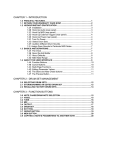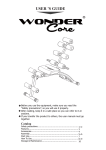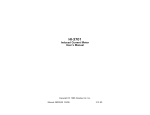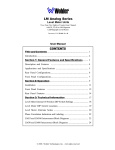Download Instruction Manual - Cole
Transcript
OMEGA Model 156 Strip Chart Recorder User’s Manual 0115-0196 • 11/4/99 Table of Contents Introduction..........................................................................................................................................................3 Unpacking ..........................................................................................................................................................4 Specifications ......................................................................................................................................................5 General ........................................................................................................................................................5 Servo System ..............................................................................................................................................5 Chart Drive System ......................................................................................................................................5 Setup Procedures................................................................................................................................................8 Electrical Connections ..................................................................................................................................8 Setting Voltage ......................................................................................................................................8 Power Cord ............................................................................................................................................8 Chart Paper Installation ................................................................................................................................9 Pen Installation ............................................................................................................................................9 Grounding ..................................................................................................................................................10 Input Signal Connections............................................................................................................................10 Recording Procedure ..................................................................................................................................11 General Theory ................................................................................................................................................12 Power Supply..............................................................................................................................................12 Pen Drive System ......................................................................................................................................12 Chart Drive System ....................................................................................................................................12 Calibration Procedures......................................................................................................................................14 Power Supply..............................................................................................................................................14 Pen Drive System ......................................................................................................................................14 Chart Drive System ....................................................................................................................................14 Gain ......................................................................................................................................................14 Offset ....................................................................................................................................................15 Span ....................................................................................................................................................16 Special Features ..............................................................................................................................................18 Remote Chart Control ................................................................................................................................18 Remote Chart Programming/TTL ..............................................................................................................18 Operational Tips and Maintenance ..................................................................................................................20 Troubleshooting ................................................................................................................................................21 Analog Section............................................................................................................................................21 Chart Drive Section ....................................................................................................................................22 Accessories ......................................................................................................................................................23 2 Introduction The dc analog recorder is an application of advanced electronic techniques. Its solid state modular circuitry yields high performance and reliability. This graphic recorder may be used in many different applications in the medical, teaching and industrial fields where a precision instrument is of utmost importance. Measurement of dc voltage, current, temperature and a variety of other variables are made possible with the use of these recorders. 3 Unpacking Remove the packing list and verify that you have received all equipment. If you have any questions about the shipment, please call the OMEGA Customer Service Department. When you receive the shipment, inspect the container and equipment for any signs of damage. Note any evidence of rough handling in transit. Immediately report any damage to the shipping agent. NOTE: The carrier will not honor any claims unless all shipping material is saved for their examination. After examining and removing contents, save packing material and carton in the event reshipment is necessary. If the recorder fails to operate properly, check all connections, cables and fuses. Ensure that all plug-in boards are firmly seated in place. Double-check for “pilot error” before calling the factory. DO NOT RETURN RECORDERS FOR FACTORY WARRANTY SERVICE WITHOUT SPECIFIC AUTHORIZATION. 4 Specifications General Power: Wattage: Fuse: Writing Method: Chart: Dimensions: Weight: 120/240 VAC + 10%, 50/60 Hz 15 Watts 3AG Slo-Blo 0.3A @ 120V 3AG Slo-Blo 0.15A @ 240V or Two 5 x 20 Slo-Blo 0.16A @ 240V Pens are disposable fiber tipped units with self-contained ink supply. 125 mm width; 30 meter length 5.0” H x 10.8” W x 11.5” D 8.0 lb. Servo System Span-Full Scale: 1mV, 2mV, 5mV, 10mV, 20mV, 50mV, 100mV, 500mV, 1V, 2V and 5V (10mV through 50V with uncalibrated 10:1 attenuator) Input Type: Floating (±100V single ended) Input Impedance: 2.5 Megohms, 1mV to 5V ranges Pen Response: Less than 50 cm/sec Damping: Critically damped on all ranges (requires no adjustment) Accuracy: Linearity: ±5% Deadband: ±0.1% Repeatability: ±0.1% Zero Adjust: Continuously adjustable from -100% to +100% (full scale +100% suppression) Right hand zero is standard Normal Mode: 35 db Typical @ 3Hz, 100 Volts Maximum Rejection: Begins filtering @ 3Hz, 100 Volts maximum Chart Drive System Chart Drive: Chart Speeds: Chart Speed Accuracy: Control: Stepper Motor 1,2,3,4,5,6,10,12,15,20 and 30 cm per minute and per hour, switch selectable Less than 0.03% error - typical 0.02% Internal: crystal oscillator External: remote pulse train,TTL/CMOS or contact closure for start/stop 5 Figure 1: Single Channel Output/Control Location 6 Figure 2: Power Entry Module Voltage Selector 7 Setup Procedures The procedures detailed in the following paragraphs must be performed to prepare the recorder for operation. Electrical Connections Setting Voltage Check the voltage selector block located next to the power cord connector on the rear panel. The white plastic tab indicates the voltage for which the instrument has been configured. This has been factory set for the voltage appropriate to your country (120 or 240 VAC; 50 or 60 Hz). If the voltage is incorrectly set, you should reset it to the proper value before proceeding further. The recorder will not function in 100 and 220 VAC positions. 1. Insert the blade of a small screwdriver in the slot next to to the connector and pry open the fuse block. Pull the fuse block straight out. 2. Using tweezers or a pair of long nose pliers, pull the voltage selector card straight out. 3. Orient the plastic indicator for the proper voltage as indicated in Figure 2, then press the selector card back in place. 4. Ensure that the proper fuse is inserted for the voltage selected as follows: 0.3A Slo-Blo for 120 VAC and 0.15A Slo-Blo for 240 VAC, 3AG or 0.16A Slo-Blo for 240 VAC, 5 x 20 mm 5. Snap the fuse block cover back in place. Power Cord Power to the recorder is provided by a standard modular power cord assembly. Connect the power cord to the receptacle next to the fuse block. 8 SETUP PROCEDURES Chart Paper Installation 1. Remove masking tape from the roll of chart paper and cut or tear each side to form a blunt point at the center. (DO NOT FOLD.) 2. Pull the knob on the chart paper core support, located on the rear panel of the recorder. Install paper, making sure its seats evenly on the two core supports. Release knob. 3. Lift the pen lift lever (on the left side of the instrument) to the full upright position. 4. Manually feed the pointed paper under the pen cover and across the writing area. 5. Install the paper under the paper hold down and across the paper sprockets, making sure the holes in the paper align evenly on the sprockets. 6. Lower the pen lift lever. 7. The paper is now ready for operation. NOTE: After manual advancement or rewind there may be a short delay, depending on chart speed selected. Then the chart will run at the selected speed. Pen Installation 1. Lift the pen lift lever to the full up position. 2. Remove the pen cap and store it where it can easily be found. Pens can be left uncapped for long periods of time, but greater pen life results from capping when not in use. 3. Slide the pen into the pen carriage and gently push back until the nib is firmly seated against the carriage. 4. Return the pen lift lever to the full down position. 9 SETUP PROCEDURES Grounding For best performance, the green (or green and yellow) ground wire in the power cord for the recorder and the signal source should share a common water pipe ground. The green (green and yellow) wire in the power cord is connected to the recorder ground (chassis), but not to the signal input. If the signal input does not have a third wire in its power cord, or if the instrument is not grounded, connect a wire between the recorder ground (green terminal) and the chassis of the signal source. In case of large normal-mode signals, particularly 120 Hz, connect the recorder ground (green terminal) to the source of the normal-mode signal, or to the negative recorder input (black terminal). Input Signal Connections This instrument requires a dc voltage input. Signal sources with current outputs will require a shunt resistor across the + (red) and - (black) inputs. Ohms law may be used to compute the proper value for a given input range. The formula is: R = E I Where: E is the recorder span range selected in volts. I is the maximum current signal to be recorded in amps. R is the resistance of the shunt resistor in Ohms. Electrical connections are made as follows: Signal source positive to recorder red (+) terminal. Signal source negative to recorder black (-) terminal. Right hand chart zero is standard on the recorder. Positive going signals drive the pen to the left. If an opposite presentation is desired, reverse the input leads and use the zero adjust control to position the pen to the opposite side of the chart. Negative signals will now drive the pen to the right. NOTE: This unit is calibrated for right hand zero. Reversal of the input leads may yield a ±3% full scale error. 10 SETUP PROCEDURES Recording Procedure With chart paper and pen(s) installed and recorder plugged into the proper ac source, perform the following steps for routine recording. 1. Set input span to desired range and attenuator to CAL position. 2. Set the record/stand-by switch to stand-by position. 3. Turn power switch on and chart switch off. 4. Zero pen to right side of chart using zero control knob. 5. Set record/stand-by switch to “REC” position (with input signal connected as above). 6. Adjust input span and attenuator for desired full scale range to best display input signal. 7. Turn chart drive on and set chart speed as desired. Make sure the chart paper holes are properly aligned with sprocket teeth. 8. REMOTE CHART CONTROL: Remove the jumper located on the rear terminal strip. To start the chart drive from a remote location, apply a contact closure between the “REM” and “LOC” terminals. The chart will stop when the contact is opened. NOTE: When switching from one sensitivity range to another, it may be necessary to re-zero the pen. To do so, place REC/STBY switch in “STBY,” readjust the zero knob. Return REC/STBY switch to “REC.” NOTE: If the pen is physically stalled on the chart for a few seconds, the servo system will shut down to protect the motor. The best way to reset the system is to turn the recorder off for about 5 seconds, and then back on. Pen should reactivate and continue to record normally. If the shutdown resulted from an over-range, the recorder will operate normally as soon as the input signal decreases to a level which is within the selected span range. 11 General Theory The dc input signal to the recorder is first filtered, then amplified by the pre-amp to a level which is less susceptible to noise and interference. This conditioned signal is then applied to the servo amplifier which continuously compares it to the feedback signal developed by the servo potentiometer, The difference between these two signals is a positive or negative error signal that is amplified and use to drive the servo motor, which is coupled to the servo potentiometer, in a direction as to reduce the error signal to zero. Since the recorder plate pen is mechanically coupled to the servo motor and servo potentiometer, its position on the chart represents an accurate and continuous permanent graphic record of the input signal. (See Figure 3.) Chart Recorder Power Supply Ac line voltage is reduced by step-down transformers and converted to dc by solid state rectifiers and regulators. A stable dc voltage, generated by a temperature compensated zener diode, is used as 0 reference for the servo pot. Pen Drive System A dc servo motor is used to control the servo pot and recorder pen by means of a gear driven servo drum assembly. The pen is attached to a drive cable which is wrapped around and secured to the drum. As the drum rotates, the pen is moved across the chart proportionate to the amount of drum rotation. The recorder uses OMEGA’s patented pulse modulated servo to achieve greater accuracy and less deadband than conventionally driven. Chart Drive System In this simple, reliable system an internal crystal oscillator generates pulses which are divided down by integrated circuit logic. The chart speed switch selects the appropriate pulse rate to drive the stepper motor at the desired speed. (Since the crystal frequency is not a function of line frequency, chart speeds are completely independent.) 12 GENERAL THEORY Figure 3: Basic Recorder Block Diagram 13 Calibration Procedures This recorder is designed to be simple, reliable, easy to maintain and repair. Therefore, the procedures presented here will be as simple, clear and brief as possible. For special problems, we recommend that you contact your local representative or the factory service department. Chart Recorder Power Supply There are no calibration adjustments in the power supply. Barring failure, the reference voltages will remain constant and stable. Chart Drive System The stepper drive printed circuit board has no calibration adjustments. Barring failure or gear binding, the stepper drive printed circuit board and stepper motor should give many years of reliable service. If a problem should arise, consult your local representative or factory service department. Pen Drive System The calibrations covered in this section should be performed by a qualified technician. The technician must have knowledge of working around voltages which may cause an electrical shock. NOTE: Gain, offset and span must be adjusted for each channel in multi-pen units. Gain (see Figure 4.) The gain adjustment controls the servo loop gain or “dead band” of the recorder. This can be reached through the hole in the bottom of the recorder marked GAIN. If set too high, the pen will “buzz.” If set too low, the pen will be sluggish. TO CALIBRATE: A. Short (+) and (-) inputs, (red and black connectors on back of recorder) and set pen to center scale by tuning the zero control. B. 14 Adjust gain control clockwise until pen “buzzes,” then back off counterclockwise until buzzing stops. CALIBRATION PROCEDURES C. Recheck the adjustment by moving the pen to full scale and back using the zero control. If pen “buzzes” at any point, turn gain counterclockwise until the “buzzing” stops. Offset This adjustment reduces the zero shift between input spans to minimum value. Performance of this adjustment requires the recorder input to be switched between a short circuit and a 50K ohm resistor. Connect a 50K resistor across the recorders input binding posts (+and -). 1. Allow the recorder to warm up to operating temperature (30 minutes is suggested). 2. Remove the chassis wrap of the recorder. 3. Place REC/STBY switch in STBY. 4. PLace the range (span) switch in the 100 mV setting. 5. Use the zero adjust knob to set the pen to midscale. 6. Switch the range switch to the 1mV position. 7. Return the pen to the setting in step “E” with the E potentiometer in the pre-amp circuit. (Figure 4.) 8. Place the REC/STBY switch in REC. 9. Return the pen to the setting in step “E” with the 1 potentiometer in the pre-amp circuit. (Figure 4.) 10. These adjustments are interactive so it will be necessary to repeat steps 3-9 until minimum pen movement is achieved. 11. Remove the 50K resistor. 15 CALIBRATION PROCEDURES Span (See Figure 4.) This adjustment enables the technician to adjust the recorder so that a calibrated full scale input signal will move the pen to the full width of the chart. The first span adjustment can be reached through a hole in the bottom of the recorder marked SPAN. The second span adjustment is normally not necessary and the bottom panel must be removed to gain access to this adjustment. TO CALIBRATE: 1. Allow the recorder to warm up to operating temperature. (30 minutes is suggested.) 16 2. Set the recorder to the 1 mV position and the signal source to zero output. 3. Carefully set the pen to zero by turning the zero control on the recorder control panel. 4. Apply a 0.1% accuracy 1 mV dc signal to the input. 5. Insert a screwdriver in the hole in the bottom of the recorder marked SPAN. Move the adjustment until the the pen is at the 100% position. 6. Check all input spans with proper inputs for 100% +0.5% deflection. Check the zero in all ranges and reset as necessary. CALIBRATION PROCEDURES NOTE: If the spans for the ranges from 200mV through 5V DO NOT deflect 100% + 0.5%, continue with the following steps: G. Remove the Chassis wrap (Figure 4). H. Set the range (span) switch to the 1V position. Check the zero and reset as necessary. I. Apply a 1V 0.1% accuracy dc signal to the input. J. Adjust the 500 mV/1/2/5V range calibration potentiometer located on pre-amp PCB (See Figure 4) for 100% + 0.5% pen deflection. K. Check all inputs from 200mV to 5V with proper inputs for 100% +5% pen deflection. There are no additional calibration points on the recorder. Figure 4: Bottom COver Mounting Screw and Gain/Span Control Access Location 17 Special Features Remote Chart Control The remote chart control provides the ability to turn the chart drive on and off from a remote location when a contact closure is made between terminals “REM” and “LOC” of the terminal strip on the rear panel. This feature is standard. Remote Chart Programming/TTL The recorder chart drive system is designed to operate from an external frequency source (including TTL levels). The chart can be run at time rates other than those built in the recorder. This mode is obtained by applying a pulse train (see below) to the “REM” terminal and the “COM” terminal on the rear panel terminal strip. NOTE: The jumper between the “REM” and the “LOC” terminal must be removed for this programming. PULSE TRAIN SPECIFICATIONS: 0 (Lo) state voltage +0.5V or less 1 (HI) state voltage +3V to 10 volts maximum Minimum pulse width: 100 microseconds Pulse frequencies up to 10 K Hz may be used providing the chart speed selector is set to limit actual chart movement to 50 cm/min or less. A 50 cm/min paper speed can be obtained by applying a 250 Hz external frequency and setting the chart selector switch in the 30 cm/min. position. The formula is Chart Speed = Where: FxS 150 Hz F = external frequency in HZ S = Selected chart speed When the external frequency is set to 150 Hz, the chart drive will run at the speeds marked on the top panel selector switch. If the external is increased (or decreased) by 10% of standard 150 Hz rate, the actual chart speed will be 10% faster (or slower in the case of a decrease) than the setting on the panel selector switch. 18 SPECIAL FEATURES EXAMPLE: The selector switch is set at 30 cm/min and the external frequency changed to 165 Hz (a 10% increase). The chart will now run at 33 cm/min. NOTE: Changes of external frequency affect all selector speeds by the same factor. The recommended maximum chart speed for start-stop operation is 50 cm/mi. If the frequency is “swept” (no start-stop), it is possible to run faster than 50 cm/min; however, sweep rates must be gradual enough to assure accurate mechanical tracking. 19 Operational Tips and Maintenance Chart paper and pens have been carefully matched for optimum writing and minimum “bleed.” Substitutions could cause improper writing. Keep pen tips covered when not in use to prolong writing life. NOTE: If the pen is left uncapped for long periods of time and dries out, it may be revitalized by dipping in water for a few seconds. Allow the recorder to warm up for about 30 minutes if high accuracy/stability recording is desired. Firm tension on the paper roll and correct alignment of the chart paper holes on the sprocket teeth are required for proper chart paper feed. The exterior surfaces of the recorder should be cleaned periodically by wiping with a soft damp cloth. Water may be used to remove ink, etc.; however, solvents should not be used as they may damage or destroy the finish. 20 Troubleshooting The modularity and simplicity of this recorder make it possible to isolate the problem area in many cases. Once you have done this, a quick call to our Customer Service Department will bring you needed advice or a replacement part. While it is impossible to think of every problem possibility, the following chart will give you suggestions on how to solve the most common recorder problems. Analog Section Symptom Probable Cause Remedy Pilot light does not light, and recorder is inactive. Ac power source disconnected. Connect ac power source. Fuse blown. Replace fuse. Power entry module has wrong voltage selected. Check power entry module voltage setting. Signal input leads disconnected. Check input leads on rear of recorder. Pilot light on, but recorder is inactive. Pre-amp/servo driver interconnect harness Check interconnect harness disconnected. installation. Excessive deadband. Noise on pen trace. Gain set too low. Adjust gain control through hole in bottom of recorder. Defective pre-amp/servo driver circuit board. Replace pre-amp/servo driver circuit board. Defective servo motor. Replace servo motor. Gain set too low. Adjust gain control hole in bottom of recorder. Excessive normal mode signal. Connect ground terminal to source of normal mode signal. Recorder ground not connected to signal source ground. Provide a common ground for third for third wire (green or green and yellow) in power cord. Pen drive cable to loose. Tighten pen drive cable. Pen carriage dragging on slide rod. Lubricate slide rod with oil or grease. Noisy input signal from signal source. Check signal source. Extremely noisy power line. Check power line. 21 TROUBLESHOOTING Noise on pen trace (cont.) Gain set too high. Adjust gain control through hole in bottom of recorder. Recorder ground not connected. Provide a common ground for third wire (green or green and yellow) in power cord. Defective bearing in servo motor. Lubricate servo motor with light oil or replace. Pen carriage slide rod dirty. Clean and lubricate rod with oil or grease. Servo driver gain set too low. Adjust gain control through hole in bottom of recorder. Defective servo motor. Replace servo motor. Defective servo pot. Contact distributor or service rep. Pens will stop moving but will catch up if physically pushed. Defective bearing in servo motor. Lubricate servo motor with light oil or replace. Pen writes poorly. Ink supply depleted. Replace pen. Pen tip dried out. Revitalize by dipping in water for a few seconds. Pen trace has isolated steps. Chart Drive Section Chart drive inoperative. Defective chart drive motor. Replace chart drive motor. Defective chart drive. Check ac power connections to circuit board. Check dc voltages on circuit board. Lubricate chart drive shaft. Gear train binding. No chart drive in particular Loose or defective connections at speed chart speed. selector and/or circuit board connector. Fuse blows. 22 Adjust chart motor for gear mesh. Check and repair connections. Defective component on circuit board. Replace defective circuit board. Internal fault. Contact distributor or service rep Accessories Chart Paper, 125 mm (5”) 0100-0017-06 Pen, Pen, Pen, Pen, 0100-0105-06 0100-0106-06 0100-0107-06 0100-0108-06 Blue, Short Nib Red, Short Nib Black, Short Nib Green, Short Nib Fuse, (Slo-Blo) 0.3A, 3AG Fuse, (Slo-Blo) 0.15A, 3 AG Fuse, (Slo-Blo) 0.16A, 5 x 20 mm Power Cord (Standard Model) Power Cord (International Model) Transformer Assembly Potentiometer (Servo, Rebalance Pot) Motor Assembly (Servo) Motor Assembly (Stepper Chart) PCB Assembly (Servo) PCB Assembly (Pre-Amp) PCB Assembly (Stepper Chart Drive) PCB Assembly (Chart Select) Pinion Gear-Chart Motor Feet, Rubber, Adhesive Knob, 0.25” Shaft Knob, 0.125” Shaft Knob, Cap 5120-0006 5120-0007 5120-0033 6040-0005 CRX70 9500-0140 4750-0037 9501-6097 9501-3255 9816-0045 9800-0073 9800-0080 9800-0075 9050-0259 2850-0005 2405-0033 2405-0032 2405-0035 IMPORTANT: Always specify model number, options and serial number when ordering replacement parts and sub-assemblies. 23 WARRANTY/DISCLAIMER OMEGA ENGINEERING, INC. warrants this unit to be free of defects in materials and workmanship for a period of 13 months from date of purchase. OMEGA Warranty adds an additional one (1) month grace period to the normal one (1) year product warranty to cover handling and shipping time. This ensures that OMEGA’s customers receive maximum coverage on each product. If the unit should malfunction, it must be returned to the factory for evaluation. OMEGA’s Customer Service Department will issue an Authorized Return (AR) number immediately upon phone or written request. Upon examination by OMEGA, if the unit is found to be defective it will be repaired or replaced at no charge. OMEGA’s WARRANTY does not apply to defects resulting from any action of the purchaser, including but not limited to mishandling, improper interfacing, operation outside of design limits, improper repair, or unauthorized modification. This WARRANTY is VOID if the unit shows evidence of having been tampered with or shows evidence of of being damaged as a result of excessive corrosion; or current, heat, moisture or vibration; improper specification; misapplication; misuse or other operating conditions outside of OMEGA’s control. Components which wear are not warranted, including but not limited to contact points, fuses and triacs. OMEGA is pleased to offer suggestions on the use of its various products. However, OMEGA neither assumes responsibility for any omissions or errors nor assumes liability for any damages that result from the use of its products in accordance with information provided by OMEGA, either verbal or written. OMEGA warrants only that the parts manufactured by it will be as specified and free of defects. OMEGA MAKES NO OTHER WARRANTIES OR REPRESENTATIONS OF ANY KIND WHATSOEVER, EXPRESSED OR IMPLIED, EXCEPT THAT OF TITLE, AND ALL IMPLIED WARRANTIES INCLUDING ANY WARRANTY OF MERCHANTIBILITY AND FITNESS FOR A PARTICULAR PURPOSE ARE HEREBY DISCLAIMED. LIMITATION OF LIABILITY: The remedies of purchaser set forth herein are exclusive and the total liability of OMEGA with respect to this order, whether based on contract, warranty, negligence, indemnification, strict liability or otherwise, shall not exceed the purchase price of the component upon which liability is based. In no event shall OMEGA be liable for consequential, incidental or special damages. CONDITIONS: Equipment sold by OMEGA is not intended to be used, nor shall it be used: (1) as a “Basic Component” under 10 CFR 21 (NRC), used in or with any nuclear installation or activity; or (2) in medical applications or used on humans. Should any Product(s) be used in or with any nuclear installation or activity, medical application, used on humans, or misused in any way, OMEGA assumes no responsibility as set forth in our basic WARRANTY/DISCLAIMER language, and additionally, purchaser will indemnify OMEGA and hold OMEGA harmless from any liability or damage whatsoever arising out of the use of the Product(s) in such a manner. RETURN REQUESTS/INQUIRIES Direct all warranty and repair requests/inquiries to the OMEGA Customer Service Department. BEFORE RETURNING ANY PRODUCT(S) TO OMEGA, PURCHASER MUST OBTAIN AN AUTHORIZED RETURN (AR) NUMBER FROM OMEGA’S CUSTOMER SERVICE DEPARTMENT (IN ORDER TO AVOID PROCESSING DELAYS). The assigned AR number should then be marked on the outside of the return package and on any correspondence. The purchaser is responsible for shipping charges, freight, insurance and proper packaging to prevent breakage in transit. For WARRANTY RETURNS, please have the following information available BEFORE contacting OMEGA: 1. P.O.number under which the product was PURCHASED, 2. Model and serial number of the product under warranty, and 3. Repair instructions and/or specific problems relative to the product. For NON-WARRANTY REPAIRS, consult OMEGA for current repair charges. Have the following information available BEFORE contacting OMEGA: 1. P.O. number to cover the COST of the repair, 2. Model and serial number of product, and 3. Repair instructions and/or specific problems relative to the product. OMEGA’s policy is to make running changes, not model changes, whenever an improvement is possible. This affords our customers the latest in technology and engineering. OMEGA is a registered trademark of OMEGA ENGINEERING,INC.

































